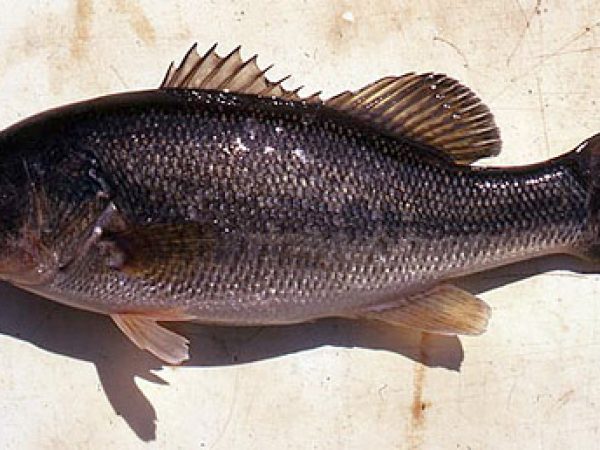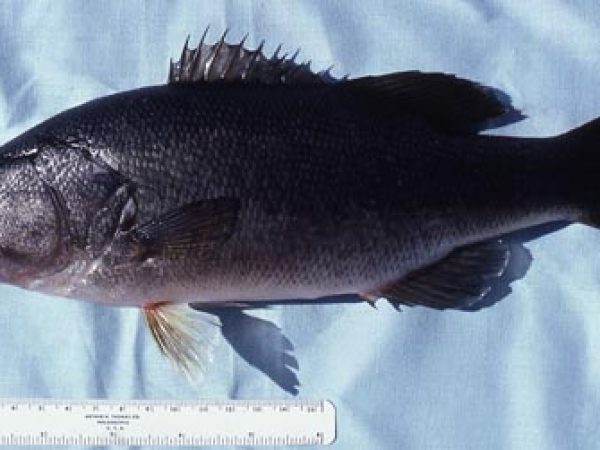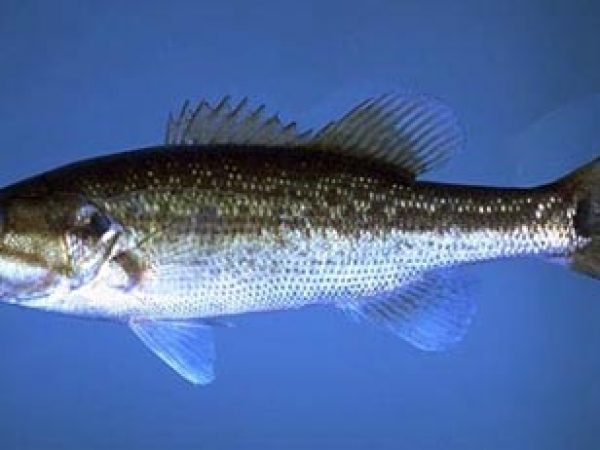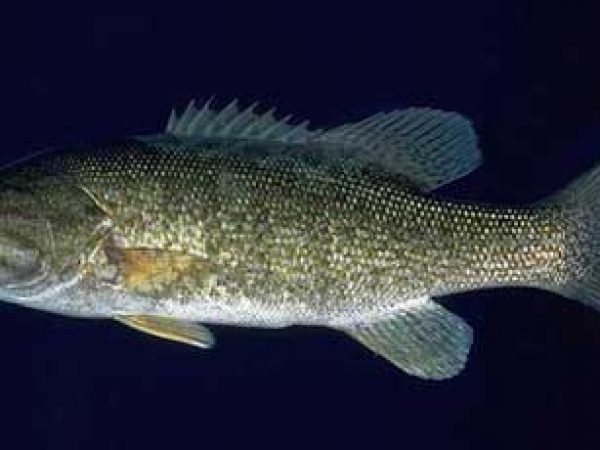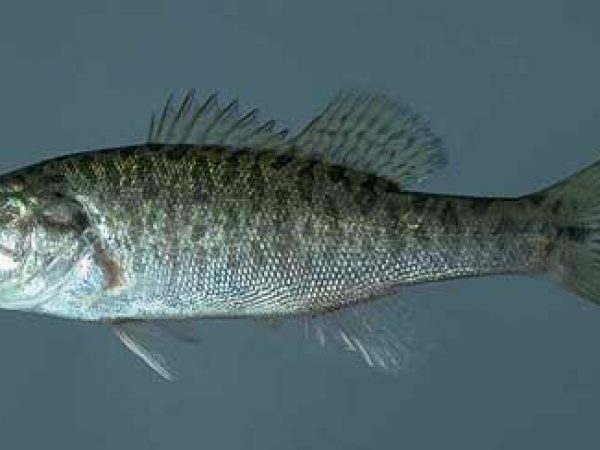Largemouth Bass
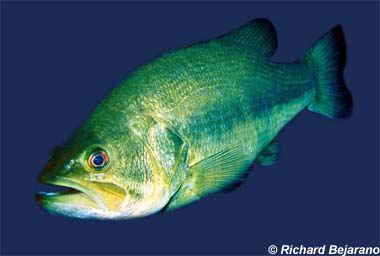
Micropterus salmoides
Not all fish called bass are in the same family, and the largemouth bass is in the sunfish family, Centrarchidae. Originally the largemouth bass were localized to the Eastern United States, but because of their popularity as a sport fish and their ability to thrive in a variety of environments, they have been successfully exported and populated, making them one of the most widely distributed fish in the world. Bass fishing is a $60 billion dollar industry.
Order – Perciformes
Family – Centrarchidae
Genus – Micropterus
Species – salmoides
Common Names
Common names in the English language are largemouth bass, bass, American black bass, bayou bass, bigmouth bass, black bass, bucket mouth, chub, green bass, green trout, lake bass, large-mouth bass, largemouth, largemouth black bass, line side, marsh bass, northern largemouth bass, Oswego bass, slough bass, southern largemouth, trout, and welchman. Other common names include achiga (Portuguese), achigan (French), achigan à grande bouche (French), bas dehanbozorg (Persian), bass wielkgebowy (Polish), biban cu gura mare (Rumanian), black-bass à grande bouche (French), bol’sherotyi chernyi okun’ (Russian), buraku basu (Japanese), fekete sügér (Hungarian), forelbaars (Dutch), forellenbarsch (German), huro (Spanish), isobassi (Finnish), khorshid mahi baleh kuchak (Persian), lakseabbor (Norwegian), lobina negra (Spanish), okounek pstruhový (Czech), Okuchibasu (Japanese), ostracka (Czech), ostracka lososovitá (Slovak), perca americana (Spanish), perche d’amérique (French), perche noire (French), perche truite (French), perche truitée (French), persico trota (Italian), stormundet black bass (Danish), stormundet ørredaborre (Danish), tam suy lo ue (Cantonese), zwarte baars (Dutch), and öringabborre (Swedish).
Importance to Humans
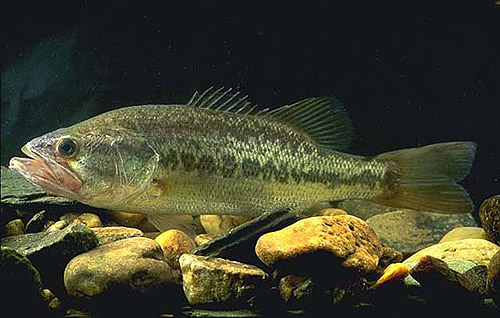
Some surveys list bass fishing as the number one participation sport, while others place it in the upper five. According to U.S. Fish and Wildlife Service statistics, 43 percent of freshwater anglers fish for bass, 34 percent fish for panfish, 30 percent for catfish/bullhead, 30 percent for trout and 28 percent for crappie. Fishing is big business and a major American institution. America’s 30 million bass anglers are the basis of a $60 billion industry with one in every five fishing every year.
Fishing
The largemouth bass is among the most sought after species of freshwater game fish in the world. Due to its broad range and popularity as a sport fish, numerous fishing methods have been devised to catch this fish. Numerous artificial lures have been
developed to entice these fish into biting including plastic worms, jigs, plugs, and spinners. Among the most exciting methods of fishing for the largemouth bass involves surface plugs which can incite vicious strikes on the surface where they are visible to the angler. Live bait fishing is also popular among bass fishers. Night crawlers, leeches, crawfish, and minnows are all commonly used live baits in different regions of the U.S.
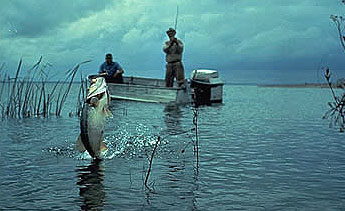
Evening and morning times are usually the best times when fishing for the largemouth bass. The largemouth’s liking for heavy cover makes it a challenge to land. A hooked largemouth usually heads for the surface, the opens it mouth wide, shaking its head or jumping in an attempt to throw, or get rid, of the hook. Once it has done this, it will dive under the cover and begin to wrap the line around logs and weeds located in the water.
Largemouth bass flesh is moderately firm and has a mild flavor. If taken from lakes where the predominant cover is weeds, the flesh may have a grassy taste.
Conservation
The largemouth bass is widely distributed and as such, is not listed as endangered or vulnerable with the World Conservation Union (IUCN). The IUCN is a global union of states, governmental agencies, and non-governmental organizations in a partnership that assesses the conservation status of species.
> Check the status of the largemouth bass at the IUCN website.
Geographical Distribution

This bass is one of the most widely distributed fishes in the world. This is due in large part to the popularity of bass as a sport fish which has lead to the introduction of largemouth bass populations into many areas where they are not native. Their current range includes the U.S., South Africa, Europe, Guam, Japan, Lebanon, New Zealand, and the Philippines.
The original range of the largemouth bass is most of the eastern half of the United States, however it is now found generally in the majority of the United States, including swamps, ponds, lakes, reservoirs, creeks and large rivers.
Habitat
The largemouth bass lives in all types of water, including swamps, ponds, lakes, reservoirs, creeks and large rivers. The bass can even be found in estuaries. It prefers weedy oxbows and clears floodplain lakes. Since it is generally a warm water (81-86°F, (27.2°-30°C)) fish, it is seldom found at depths of more than 18.8 feet. During the winter, largemouth bass generally will move into deeper waters. In the spring, largemouth’s migrate into bays that have warmed up sooner than that of the main body of water.
During the day, largemouth bass may cruise above aquatic plants at depths of 3.1-9.4 ft, or lie under lily pads or in the shade of overhanging trees, piers, or brush. In the evening hours, largemouth bass tend to move into shallow water to feed. After night falls, they return to deeper water, where they rest on the bottom under logs or trees. In cold temperate climates, largemouth bass generally move into deeper waters during the winter months followed by movement to warmer, shallow waters in the springtime.
Biology
Distinctive Features
The largemouth bass has a large, slightly sloping mouth. Its body is slender to robust, slightly compressed laterally, and oval in cross section. The corner of the mouth extends past the eye, hence its common name.
The two recognized subspecies of the largemouth bass are the northern largemouth (Micropterus salmoides salmoides) and the Florida largemouth (Micropterus salmoides floridanus).
The Florida largemouth has slightly smaller scales than the largemouth bass in relation to the size of its body. It has 69 to 73 scales along the lateral line, compared to 59 to 65 on the northern largemouth. It grows faster and reaches larger sizes in warm waters than the northern largemouth, leading to its popularity in stocking efforts across the U.S.
The species most often confused with the largemouth bass is the spotted bass (Micropterus punctulatus). Sometimes referred to as the Kentucky bass, its range overlaps with that of the largemouth bass and has similar coloration patterns. It can be distinguished from the largemouth bass in several ways. The spotted bass has its spiny and soft dorsal fins fused. Also, its upper jaw is noticeably smaller than that of the largemouth bass and does not extend beyond the eye.
The smallmouth bass, M. dolomieu, is another popular sport fish. It is restricted to a more northern range than the largemouth with its southernmost populations in northern Alabama and Oklahoma. The smallmouth bass may be distinguished from the largemouth by several characteristics including its bronze to brown coloration, its mottled pattern of dark bands, and its noticeably smaller mouth.
Other similar species found in regions of the southeastern U.S. include shoal bass (M. cataractae), red-eyed bass (M. coosae), and Suwannee bass (M. notius), while in Texas there is a population of the Guadeloupe bass (M. treculi). The mouths of all of these species are smaller than the mouth of the largemouth bass. These four species also tend to be smaller in length with the largest species reaching a maximum length of 18.5 inches (47 cm).
Coloration
The back and head are dark green to light green in color with lighter sides and a whitish belly and underside of the head. A prominent lateral stripe may be seen running from the snout through eye to the base of the tail. Towards the tail, there is a series of blotches of varying size. These blotches evolve into a solid, even stripe on the caudal peduncle. The eye is golden brown. Vertical fins lightly pigmented, paired fins generally clear; caudal fin alike in young and adult. Adults from mud-bottom lakes are dark olive brown to black, with markings hardly distinguishable. Males in breeding condition tend to be darker in overall color.
Dentition
The largemouth bass has well-developed pharyngeal jaws consisting of six major pads of caniform teeth in the upper pharynx and two pads in the lower pharynx. There are no teeth present on the tongue.
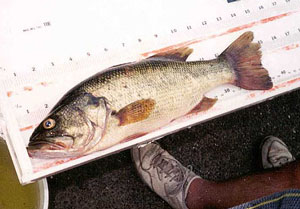
Size, Age, and Growth
The average length is 18 inches but the largemouth bass may attain a length of 24 inches or more. The world record largemouth bass was caught in Montgomery Lake, Georgia in 1932. The fish weighed 22 pounds, 4 ounces (10.09 kg).
Females may reach a maximum age of 9 years, while the males reach a maximum of 6 years.
Food Habits
Largemouth bass may consume small fish, insects, mosquitoes, blackfly larvae, mayfly nymphs, worms, adult insects, mussels, crayfish, snails, tadpoles, frogs, small fish, salamanders, mice, turtles. In general largemouth bass feed at all hours, but most often in the early morning or late in the day. In some cases, the prey is not completely swallowed up initially; it is caught and held in the jaws and then it is sucked in.
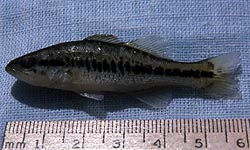
Reproduction
The largemouth bass generally does not spawn at temperatures much below 64°F (17.8°C). Optimal spawning conditions is when the water temperature is around 18.9°-20.0°C. which correlates to between February (for the extreme southern end of its range) and July (in northern latitudes). The selection of nest sites by the male generally begins when water temperatures reach 60°F (15.6°C). The male largemouth bass begins the spawning process by clearing out a small depression in the bottom substrate. The nest are cleared in fairly shallow water on bottoms composed of sand, gravel, or pebbles. The male then attracts a gravid (egg laden) female and together they pass over his bed, releasing sperm and eggs. She may release from 2,000-145,000 eggs with much of this variation attributed to her physical size. Shortly after spawning, the female departs and the male is left to guard the developing eggs. The male will fast while he defends the eggs from predators and debris until they hatch 3-7 days later.
Upon hatching, young largemouth bass fry are transparent and 3 mm in length. After hatching, the young remain in the bottom of the nest until the yolk is absorbed from the eggs, which usually lasts a period of 6 to 7 days. They then rise from the nest, and begin feeding on zooplankton and schooling, where they are 5.9- 6.3 mm long and have changed color to become pale green. As young largemouth bass begin to grow, their diet changes to insects and other small fishes and then eventually switches to larger fishes, salamanders, crayfish, and a variety of other small organisms.
The largemouth bass may form hybrid fish by spawning with the smallmouth bass, rock bass, bluegill, warmouth, and black crappie.
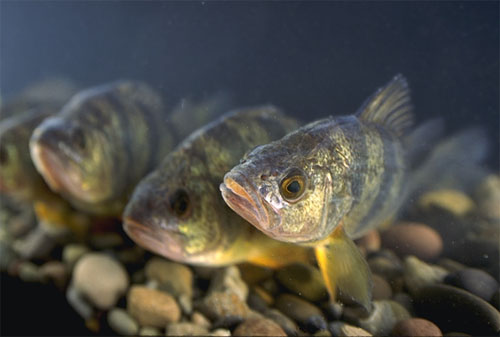
Predators
Largemouth bass larva and juveniles may fall prey to yellow perch (Perca flavescens), walleye (Stizostedion vitreum), northern pike (Esox lucieus), and musky as well as water birds such as great blue herons (Ardea herodias) and kingfishers (Ceryle alcyon). However, adult largemouth bass are considered top predators in many habitats where they reside and rarely become prey items due to their size, swimming speed, and protective dorsal spines.
Parasites
An enemy of the largemouth bass is the bass tapeworm, which attacks the reproductive organs, resulting in sterile bass. The ectoparasitic protozoan, Scyphidia tholiformis, is one of the most common parasites. The fungus Saprolegnia may attack dead eggs. Parasites such as protozoa, copepods, roundworms, tapeworms, flatworms and leeches are common in the largemouth bass.
Taxonomy
Lacépède was the first to describe this fish in 1802. He gave it the scientific name Labrus salmoides. In 1876, Nelson described this fish as Micropterus nigricans and in 1878 Jordan described it as Micropterus pallidus. Finally in 1884, Forbes described the fish as belonging to Micropterus salmoides, which is currently the valid scientific name.
There are two recognized subspecies the northern largemouth bass (Micropterus salmoides salmoides) and the Florida largemouth bass (Micropterus salmoides floridanus). In 1965, Smith described the subspecies Micropterus salmoides salmoides, while in 1949 Bailey and Hubbs described a second subspecies as Micropterus salmoides floridanus.
Prepared by: Andrew Bridges and Cathleen Bester
